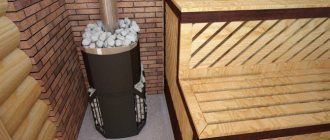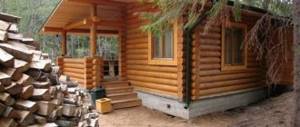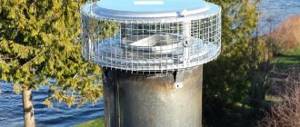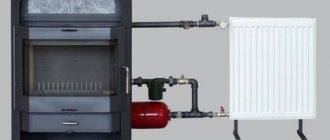Mechanism of operation
A metal stove placed in a house, garage or bathhouse must be equipped with a chimney to remove carbon monoxide and organize draft. During the process of heating the furnace, this pipe can reach very high temperatures, about 200-500 ℃, which is unsafe for people in the room.
If you install a heat exchanger on the chimney, you can significantly increase the efficiency of the stove, and also protect yourself from direct contact with a hot surface. In a tank or coil installed on the chimney, the coolant will be water, however, you can also install an air heat exchanger on the chimney pipe. Due to the direct contact of the chimney with the coolant, their temperature indicators are balanced, that is, the water or air gradually heats up, and the walls of the pipe cool down.
As the temperature of the water inside the register rises onto the pipe, it rises upward, where it enters the water tank through a special fitting. Through the inlet fitting located at the bottom of the heat exchanger, cold water enters it, replacing warm water. This circulation continues constantly, and the water can heat up to very high values.
An air radiator on a chimney pipe has a similar operating principle. Cold air enters the heat exchanger from below, and after heating it rises up and is supplied through the pipeline to the heated rooms. In addition, the radiator fins also give off heat. An air heat exchanger is optimal for heating attics in a country house or dressing rooms of a bathhouse, if such rooms are heated only from time to time. It is not advisable to organize water heating in them, since you will have to constantly fill and drain water from the system.
Heat exchanger for chimney
When using a furnace to heat your home, the question arises, how to increase the productivity of the heating device? This can be done by installing a heat exchanger on the chimney. It will use the energy of fuel combustion products to heat the room.
Types of installations
This unit uses thermal energy from the chimney pipe, which it transfers to the coolant. The configuration of the device depends on the type and design of the chimney and the material from which it is made. The coolant can be:
- plain water;
- air;
- any liquids that do not freeze;
- oil.
Heat exchanger options for chimneys
All heat exchangers are divided into air and liquid. Air installations have a fairly simple design. You can make them yourself using available materials. The disadvantage of this unit is its low productivity.
A heat exchanger that uses liquid as a coolant has a more complex design. For this installation to work effectively, you need to follow some installation recommendations. But if everything is done correctly, a chimney with a heat exchanger can serve as a full-fledged heating system for a small country house or bathhouse.
Air heat exchanger design
The air heat exchanger for the chimney is a hollow body that is connected to the heating system using special pipes. A special braking device is installed inside the housing for gases that are formed during fuel combustion. Most often this is a specific damper system with small cutouts for air flow. In some models of heat exchangers, it is possible to regulate the draft force in the smoke exhaust channel, which affects the productivity of the unit.
Air heat exchanger (convector)
This device works thanks to the principle of convention. There is a hole at the bottom of the heat exchanger through which cold air enters the body. It quickly heats up from the high temperature of the chimney, after which it returns back into the room. Thus, in a few minutes the room where this unit is installed becomes noticeably warmer.
The advantage of this design is a significant increase in stove performance. When using the same amount of solid fuel, you can obtain several times more thermal energy.
Liquid heat exchanger design
This unit is a regular coil with water, which is in contact with the outer surface of the chimney. Thin tubes are inserted into a metal casing and insulated with basalt wool. Copper is used as a material for the manufacture of coolant tubes. It has a high thermal conductivity coefficient, which makes it possible to minimize the diameter of the pipeline.
The coil is directly connected to the heating system and installed on the chimney. At the top point of the unit there should be a special tank, which is designed to collect liquid that has expanded from heating.
Liquid heat exchanger
HOW TO MAKE A HEAT EXCHANGER (COIL)
Operating principle of liquid heat exchanger:
- due to the high temperature that forms inside the chimney, the liquid in the pipeline heats up;
- hot water expands, causing it to move along the coil and flow by gravity into the heating radiator;
- in a heating device, hot liquid displaces cold liquid;
- the process is repeated from the beginning. Cold water flows back into the heat exchanger, where it is heated again.
Despite the high productivity of this unit, it has many disadvantages. First of all, a liquid heat exchanger is quite difficult to install; you need to constantly monitor the operation of the heating system and monitor pressure indicators. This installation cannot be used in winter, when the liquid in the coil may freeze. You can also get the opposite effect when, due to the reduced temperature in the chimney, the draft decreases, which entails an increase in the volume of firewood to obtain a certain amount of heat.
What materials can be used?
A high-quality heat exchanger for the chimney is made of food-grade austenitic stainless steel. It works great under constant exposure to high temperatures. Nickel, which is contained in the alloy, forms a special film on the surface of the pipeline that is resistant to aggressive environments.
Tensile strength and elongation values for galvanized steel
Galvanized steel can be used as a material for the heat exchanger pipe. With strong heating above 200°C, the zinc contained in the metal begins to evaporate. At a temperature of 500°C, its concentration in the air becomes dangerous to human health. But if your heating system operates in a smaller temperature range, this material is completely safe.
How to make this device yourself?
Making a heat exchanger for a chimney with your own hands is quite simple. To do this, use the following materials:
- metal sheet measuring 0.35 m x 0.35 m - 2 pcs.;
- pipe with a diameter of 0.032 m and a length of 2.4 m - 1 pc.;
- pipe with a diameter of 0.058 m and a length of 0.3 m - 1 pc.;
- cylindrical metal container with a volume of 20 l – 1 pc.
Water heat exchanger made of stainless steel
Step-by-step instructions for making a heat exchanger:
- Cut two circles with a radius of 0.15 m from sheets of metal. They will act as plugs.
- On a sheet of metal, mark the locations for placing the pipes. The largest circle with a diameter of 58 mm should be in the center, and along the contour there should be eight small circles with a diameter of 32 mm.
- A pipe with a diameter of 5.8 cm must be cut into eight equal parts using a grinder.
- Weld a plug to one end of the largest size pipe.
- Weld each pipe with a diameter of 3.2 cm to a metal circle one by one.
- Place another plug on the opposite side of the pipes, then weld it.
- Using a grinder, cut off the bottom of the metal container.
- On the side surface of the metal casing, cut two holes on opposite sides. Their diameter must correspond to the parameters of the chimney.
- Weld pipes to the prepared holes, with which the unit will be connected to the chimney.
- Insert the prepared core into the casing with pipes. Carefully secure the structure using welding.
- Connect the heat exchanger to the chimney.
- Treat the finished unit with heat-resistant paint.
Homemade heat exchanger
DIY copper tube heat exchanger
Copper tube heat exchanger
This unit is a coil of copper pipe that wraps around the chimney. It heats up quickly, and the air that moves inside becomes warm. To ensure high efficiency of this system without the use of a pump, the length of the coil should not be more than 3 m.
This design can be made using argon welding. The option of fastening using tin is allowed. In this case, all surfaces must be degreased with phosphoric acid.
The ends of the copper pipe must have an external thread for connecting an external water tank. It must be located above the coil, which will ensure maximum productivity of the system.
We use corrugation
This heat exchanger option is the simplest and requires the minimum amount of material costs. To do this, use a long corrugated pipe. It needs to be wrapped around the chimney.
Application of corrugated pipes for the manufacture of heat exchangers
The air inside the corrugation will heat up very quickly. It is enough to simply redirect it to the next room. To increase heat transfer, wrap food foil around the corrugation.
For safe operation of a heating system using heat exchangers of different configurations, it is necessary to constantly check the connections to the chimney. If you detect the slightest gaps, immediately restore the tightness of the seams.
Instructions for making a tank
Often in stores you can buy a heat exchanger for a heating pipe with an already made water circuit. All that remains is to mount it on the new factory stove and you can use it. However, if you wish, you can make a heat exchanger for the chimney pipe with your own hands.
The following materials will be required:
- sheets of steel and pieces of stainless steel pipes of different sections with walls 1.5-2 mm thick;
- 1″ or 3/4″ fittings to connect the water circuit to the heating system;
- large water tank made of galvanized or stainless steel with a volume of 50-100 liters;
- flexible hoses or pipes made of copper or steel for hot water;
- tap for draining water from the system.
Work on assembling a heat exchanger with a tank consists of the following steps:
- Drawing development. Based on the type of stove and the diameter of the chimney, the dimensions of the tank are determined. In simple metal stoves with a direct chimney at the outlet, the gases are very hot, so the heat exchanger can be quite large - about 50 cm high.
- The inner diameter of the walls of the storage tank must be selected so that it fits tightly onto the chimney pipe. The outer diameter of the tank should be 1.5-2.5 times larger than the internal cross-section. Such parameters allow you to quickly heat the coolant and ensure its free circulation. If the gases coming out of the furnace are not very hot, then it is better to install a heat exchanger on the chimney pipe for heating of smaller sizes, so that condensation does not accumulate and there is good draft.
- You need to use a welding machine to fasten all the structural elements together, making sure that the seams are airtight. Fittings for water circulation are welded at the top and bottom of the tank.
- The water boiler is seated very tightly on the smoke fitting, additionally treating the seams with heat-resistant sealant. In the upper part of the tank, an adapter is attached in the same way to an insulated pipe, which is led outside through the ceiling or wall.
- The heating circuit with coolant is connected to the storage tank. The incoming pipe with cold water is led through a fitting to the tank with an inclination of 1-2 degrees. The hot water pipe, connected to the tank through the upper fitting, has an inclination of 30 degrees. In this case, the storage device itself is mounted above the heat exchanger.
- A tap is installed at the lowest point of the tank to drain the water. In the steam room it can be combined with a tap for drawing hot water.
- Before heating the stove, water is poured into the system so that the metal elements do not overheat and the seams do not burst.
- Filling the heat exchanger with water can be either manual or automatic. If you fill the water manually, you need to install a transparent tube on the outer wall to monitor the water level.
It is worth noting that the distance from the circuit to the tank should not be more than 3 meters, and it is better to take the pipe diameter no narrower than 3/4″.
Features and materials
For commercial, household and industrial purposes, devices of various types and performance are used - the specific engineering solution depends on a lot of factors:
- System task (climate control, heat removal from process equipment, freezing/storing products, technological processing of raw materials or supplies, etc.);
- System performance (calculated based on the assigned tasks);
- Type of system (possibility of using cooling systems of one type or another);
- Temperature values (minimum temperature value, maximum error);
- Coolant (air, freon-type refrigerants, glycol solutions, water, oil, etc.);
- Heat exchanger material (copper, aluminum, steel, protective coatings, etc.);
- Installation location, noise level.
Heat exchanger in the form of a coil
If the installation of the previous type of heating from a chimney pipe requires the ability to operate a welding machine, then the design of a heat exchanger in the form of a coil is much simpler. You just need to wrap a few rings of flexible aluminum or copper pipe around the chimney. These metals have a high level of thermal conductivity and are not destroyed due to corrosion.
The diameter of the tube should be convenient for connecting to the fitting of the storage tank. It is optimal to choose a pipe with a cross-section of no more than 28 mm for bending. The length of such a circuit should not exceed 3 meters in order for the water circulation to be correct. Using a flexible connection, you can connect the tank to the coil.
As a rule, coils are used to heat water, although sometimes for heating small rooms. Coils mounted on the chimneys of a metal furnace with a very high temperature of carbon monoxide perform best.
Blitz tips
- To avoid scale formation in the heating system , you must use only distilled water. A large amount of distilled water for this purpose can be produced at home by passing water vapor through a “pipe-in-pipe” heat exchanger.
- Using a homemade device for heat exchange between gases formed as a result of fuel combustion and liquid, it is necessary to carry out all installation work with the utmost care so that, as a result of insufficient sealing of the chimney, carbon monoxide does not enter the room.
- When using boilers or stoves that use natural air draft in the chimney, the cross-sectional area of the chimney inside the heat exchanger should not be less than the area of the boiler or stove pipe.
Coil installation method
You can install a coil heat exchanger on the chimney of a sauna stove or potbelly stove in a garage or shed. It will serve for heating or for heating water.
To work you will need:
- aluminum or copper tube up to 3 m long;
- 2 3/4″ fittings and a flexible hose for hot water;
- boiler with a float valve for filling with water and a valve for its use;
- tap for draining coolant from the system.
The system installation technology looks like this:
- The first step is to bend the tube so that its cross-section remains unchanged. For copper pipes less than 28mm in diameter, you can use a pipe bender without heating them. But steel, aluminum and products with large diameters require preheating with a blowtorch.
- For bending, you can use dry sand, filling the pipe with it and closing it with plugs on both sides. A spiral bend is made according to the sample, after which sand is poured in and the pipe is washed under water pressure.
- At the end parts of the tube, threads are cut for adapters for fittings, and then connected to the system.
- The resulting coil is mounted on the chimney. If you solder it with tin to the pipe, the heat transfer will be better. Preliminary degreasing is carried out with orthophosphoric acid.
- A storage tank is hung on a support or on the wall a little above the coil. Connect it to the heat exchanger with a flexible connection and install a tap at the bottom of the tank.
Note that for safe and long-term use of a heating coil, you need to install a pump that circulates water in the system and prevents overheating.
Custom designs for your project
“To implement an industrial utility network, a heat exchanger with a non-standard design or increased corrosion protection may be required. We are ready to manufacture for you a wide range of heat exchange equipment for various types of equipment - both standard sizes and according to individual drawings.”
Production of products:
- Air condensers
- Liquid (freon, glycol) evaporators
- Water air coolers
- Duct heat exchangers
- Oil and water heaters
- Oil coolers
- Coolant cooler (cutting fluid)
Depending on the design solution adopted, you can order air heat exchangers operating with the following media:
- Air - water
- Air - glycol
- Air - freon
- Air - steam
- Air - oil or coolant
Most systems use copper-aluminum heat exchangers. If necessary, you can order heat exchangers with stainless steel plates - they are characterized by increased corrosion resistance and high strength characteristics.
All products comply with Russian and international (ASME) quality standards. Thanks to the highly qualified engineering center and high-precision modern technologies, your order will be completed in the shortest possible time.
Negative points
Along with the benefits of a heat exchanger on a chimney, it is worth noting a number of negative factors. Firstly, due to this design, the temperature of the exhaust gases is significantly reduced. This can provoke excessive soot accumulation, condensation formation and poor traction.
An important point in arranging such a heating system is to calculate how much water is needed for its full functioning. If there is not enough of it, the system may overheat, the water in it will boil, and the pipes may burst. In addition, it is important to ensure the tightness of the seams.
In any case, installing a heat exchanger allows you to increase the efficiency of any furnace. For safety reasons, at least twice a year, visual diagnostics of the system and its maintenance should be carried out - cleaning soot, replacing defective elements, and so on. Then it will be possible to confidently use the heat exchanger for heating the house and heating water in the bathhouse.
Order processing in the shortest possible time
For each facility, an individual technical solution is developed that can satisfy all client requests and ensure maximum energy efficiency of the cooling system.
Professional design of cooling, heating, and air conditioning systems is the key to uninterrupted operation of the main equipment and guarantees strict compliance with established technological conditions, microclimate standards and safety requirements.
Options for making devices yourself
We offer several easy-to-make projects that, if desired, can be made from metal parts using welding and power tools.
Overview of a heat exchanger from a gas cylinder
If you install a homemade device on a potbelly stove, the heating efficiency in the room will increase by 30-40%. The smaller the garage or workshop, the higher the productivity of the device.
We suggest considering an option that is ideal for small stoves of the “potbelly stove” type, which are actively used for heating garages.
In general, a gas cylinder makes a fairly neat and efficient heat exchanger for a stove heating a small room. To further increase the heating efficiency without radically changing the design, fans can be installed on the pipes, and the number of pipes can be increased to 4-5.
Photo review of the Fehringer economizer
Factory models from popular manufacturers can serve as a sample for manufacturing. For example, the Feringer company, known for producing stoves, offers ready-made chimneys, which are essentially heat exchangers.
Let's consider models of simple design. All the parts they consist of can be made independently.
The main idea that can be taken from the advanced Fehringer models is the use of four pipes instead of one. If the stove is already installed in a garage or utility room, we remove part of the chimney and install a four-pipe economizer instead - and the temperature in the room immediately increases by several degrees.
Homemade air convector
The proposed model is made entirely of steel parts. This is a heat exchanger, which is approximately 1.5 times larger in size than a chimney.
It is a drum with tubes located perpendicular to the chimney pipe. Stainless steel was chosen for good reason - it can easily withstand high temperatures, is easy to clean and does not burn through.
To work you will need:
- steel pipe with a diameter of 30 mm (for making 8 identical sections);
- pipe fragment 50 mm (for the central channel);
- metal sheet 2 mm thick (for making 2 round plates and a casing);
- 20 liter paint can (for the chimney adapter).
It is also necessary to prepare a tool for cutting and welding metal.
This is one of the best options for an air heat exchanger for a stove chimney for a garage or utility room. The design can be simplified by welding metal partitions instead of tubes, but the principle of operation will remain the same: heated air from the chimney will be an additional source of heat for the room.
The article we recommend is devoted to the process of making a chimney directly for a potbelly stove. It is better to equip the chimney with a heat exchanger immediately during manufacturing.
Work specifics
Today, heat exchangers of various types are produced. In general, the features of their operation, as well as the design characteristics, are similar. The structural properties of such an element:
- Full body available.
- Presence of outlet and outlet pipes.
- Braking mechanism for combustion products. Its role is played by valves with cutouts that are installed on the axles.
The flaps can be turned. A zigzag chimney of varying lengths is formed. The valves can be adjusted to ensure the ratio of draft and heat transfer is as efficient as possible. Safety standards are met.
In this video you will learn how to make a heat exchanger:
Closed type water heat exchanger
The operating principle of all closed heating systems is based on the elementary laws of physics - when heated, the density of water decreases and is pushed from below by colder water, it begins to rise through the pipe, entering the expansion tank, and from there it returns to the heater along the entire circuit.
In this case, the chimney acts as a heater, which with its energy pushes water along the contour of the heating system.
Homemade coil
Homemade water heat exchanger
The design shown in the photo is the most common and simplest way to use heat from a chimney. The upper edge of the tube is connected to the expansion tank, and the lower edge to the heating circuit.
Most often, such a system is used as an auxiliary one. With its help, you can heat small rooms in which heating was not previously provided, but nothing more. It will not be able to act as the main heating, since its design has several significant disadvantages:
- The temperature on the surface of the chimney is an unstable and difficult to control value, as a result, it is impossible to regulate the degree of heating of the coolant.
- Due to the variability of temperature, it is very difficult to calculate the optimal coil length. If it is too short, the water will begin to boil and rupture the tube, and if it is too long, the coolant will not warm up to the desired temperature at all.
- The water from the expansion tank cannot be used for showering or other purposes, and this is not just due to unregulated heating. When the tank is filled with cold water, it will begin to cool the chimney through the coil, resulting in the formation of condensation and accelerating the process of soot formation on the internal walls.
- The temperature to which the chimney heats up is not enough to warm up a long circuit. With conventional heating, water passing through the system loses only 25 degrees; to maintain this figure in this situation, the entire system must be small in size.
Register heat exchanger
Factory heat exchanger
To avoid problems with homemade devices, you can purchase a register heat exchanger for the chimney pipe. Of course, the price of such a device will be higher than that of a DIY one. But the quality characteristics cannot be compared.
The principle of operation of such a device is identical to that described above, with the only difference being that all the calculations have already been made to protect the device from boiling. Unfortunately, there is no heating control here either, but there are several significant advantages compared to “homemade” ones:
- The outer casing retains heat inside, allowing the coil to warm up even at low chimney temperatures;
- Copper tubes do not come into close contact with the heating surface, this protects the device from possible boiling.
Internal structure of the heat exchanger
Installation and connection features
So, we found out that the best option is a stainless steel sauna tank on a pipe. But many will probably ask the question: what is more profitable - to use a heating element for heating or to heat it by heating the furnace? The answer depends on the number of people who will simultaneously take water procedures and how quickly the water should heat up.
If we are talking about, say, just one person, then a tank with a volume of 50 liters is quite enough for him, but for a company - at least 70 liters. And the speed at which the tank will heat up depends on the thickness of the metal - the thicker it is, the more time it will take to warm up and, accordingly, the greater the weight will be. Thus, the wall thickness of a 50 liter tank is on average 1 mm; for large containers it can be 1.5 mm.
But how to install this tank? First of all, if a tap is used for water supply (in other words, under permanent pressure), then a closed-type water supply will be needed. The best option would be a heating device, inside of which there is a coil, and therefore a reservoir is connected to the latter.
Although a slightly different option is quite possible: hang the tank on the stove. For this purpose, you can use the simplest product, the volume of which ranges from 50 l to 120 l; You can do it yourself. The best option is an 80 liter capacity - these are sold in many specialized stores.
If the tank is connected as needed, the system will function like this: the water in the coil warms up, and then rises into the container. There it begins to cool, and therefore falls back into the coil. Obviously, natural circulation occurs, in order to improve which it is recommended to take water from the “return”, which is not convenient in all cases, since you have to wait a long time for the tank to heat up.
However, the water itself can be used after the stove has been heated. However, the efficiency of the system will be higher if it provides for the possibility of switching water intake from supply to “return” (here it is more convenient for everyone). If there is an inlet/outlet from the bottom of the container, the liquid will circulate much more slowly.
The installation procedure itself will look something like this.
Stage one
. First, the tank is placed in a steam room (more precisely, under the shelves), after which it is connected to the coil through pipes.
Stage two
. The upper outlet of the container is connected to a similar outlet of the coil, while the lower outlet is connected to a similar outlet. All this is necessary to ensure normal circulation. It turns out that cold water will be drained from below, and heated water from above.
Stage three
. A special valve is installed at the inlet intended for cold water (it is also known as a blast valve).
Stage four
. According to the tank manufacturer's instructions, pressure is applied to the bath pipe, upon reaching which this valve will operate.
The finished system will function like this: the container into which water is poured will begin to heat up through a coil, and when drinking heated water, cold water will be added thanks to a special supply. As the liquid is heated, if it is not yet consumed, the pressure indicator will increase, and when the limit is reached, the valve is activated. As a result, the pressure is released.
Note! If everything is done correctly, then the bathhouse will be fully supplied with the required volume of heated water, and the pressure will be just such that it is convenient for people to wash themselves after visiting the steam room.











